


 |
July 24, 2012: Rudolf and Fred at the Dallas Zoo |
 |
July 20-25, 2012: Rudolf Lowenstein Visits Dallas |
 |
Return to the Index for 2012 |
Today, Fred and I are going to go with Rudolf to the Dallas Arboretum to see the exhibition of Dale Chihuly's glasswork installations that are in the gardens all this summer. We have seen Chihuly's work before- in Miami's Fairchild Gardens, in the Missouri Botanical Garden in St. Louis, and at the Bellagio Hotel in Las Vegas. His studio glass works are always a treat to see, and today the three of us will experience the Arboretum installation for the first time.
Getting to the Dallas Arboretum
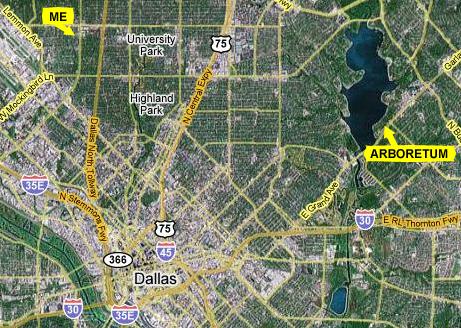 |
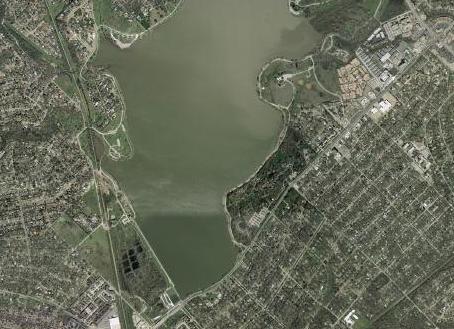 |
The bike path used to cross the top of the dam, but for one reason or another, the bike path was rerouted a year ago, and now it goes through some parkland and playing fields south of the dam, across the spillway, up Garland Road for a ways, and then back north along the lake shore.
You can also see a closer view of the Arboretum in this picture, and can begin to pick out some of the pathways through the gardens.
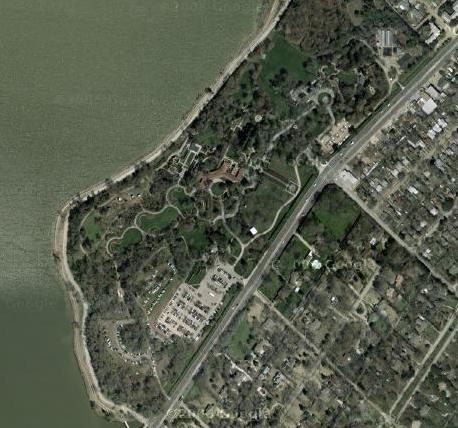 |
You can also see the maze of pathways that criss-cross the gardens.
Although we usually make a circular transit of the entire Arboretum each time we visit, our primary purpose today is to make sure that we see all of the Chihuly glass installations- and there are quite a few of them. I know that is probably not important for you to know where in the gardens each of the Chihuly installations is located, I always think it is interesting to let you follow along with us on a map or diagram. Below is a large diagram of the Dallas Arboretum, with our general route marked in yellow and the major gardens noted in red.
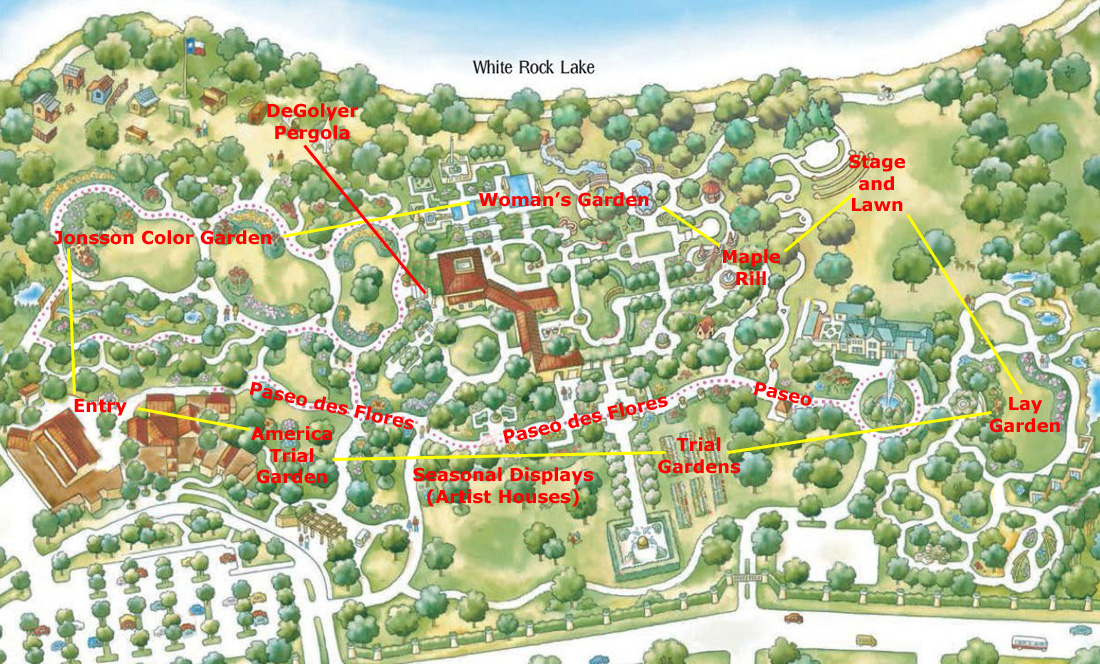
|
I'll divide up today's pictures by garden, and with each group you'll find a little inset map with our current location marked and the Chihuly installation(s) we found there also marked. Some of the installations, such as "Garden Grass," have multiple iterations and can be found in multiple locations. I will try to mark as many of them as I can. So let's head off from the parking area into the Arboretum to have a look at both the glass installations and the gardens themselves.
Cissy Thomsen Welcoming Water Wall
Installation Name: Blue Icicles
|
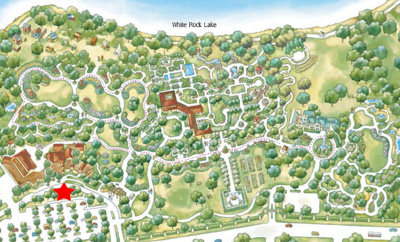
|
In 1996, Chihuly developed an element for his Icicle Creek Chandelier that he hoped could withstand the snowy winters and hot summers of Central Washington state. The resulting icicle form, both beautiful and sturdy, has become a favorite of the artist in a number of outdoor installations since then. One icicle part in your hand is remarkably heavy. Wherever they are placed outdoors, and no matter what the color, the add a startling visual punch. Here at the Arboretum, clear, turquoise and cobalt icicles reflect the Texas sunlight in dramatic fashion.
|
 |
Ginsburg Plaza
Installation Name: Mexican Hat and Horn Tower
|
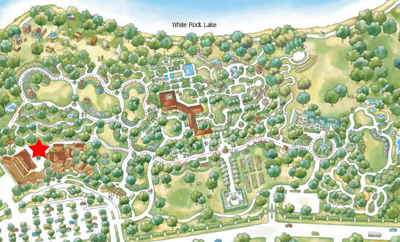
|
Mexico was one of the countries where Chihuly blew glass during the Chihuly Over Venice project and the red forms in the Mexican Hat and Horn Tower were devised there. Often, he and the team will invent a new shape for the Chandeliers or Towers and the new parts will take on a nickname- in this case, "Mexican Hats."
I want to include a closeup of this installation and a picture of Fred with it; you can see those views here and here.
The Palmer Fern Dell
|
Here, we found the first of many installations of a genre that Chihuly calls, simply, "Garden Glass." These were tall, slender grass-like shapes, sometimes straight and sometimes with curliques at the top. The color seemed to complement the place in the garden where they were located. Usually, they had different names.
Installation Name: Blue Marlins and Turquoise Reeds
|
In addition to the Blue Marlins seen at right, the fern dell also contained three sets of the Turquoise Reeds. Chihuly made the first Reeds at the Hackman factory in Nuutajarvi, a small glassblowing town in Finland. Unlike other factories, the Hackman facility has very high ceilings, which inspired Chihuly to make these elongated forms. To create the long tubular shape of a Reed, one glassblower must be elevated in a mechanical lift while blowing through the pipe to encourage the form to stretch, while another pulls the glass toward the ground. As Chihuly said, "In Finland we started making these long, cylindrical pieces which loojked like spears. This was an exciting new form. It was the first time we ever made anything like that. They can be taken anywhere; they can go outside. They are very strong pieces, and they are very dramatic."
Both the different installations were very pretty, and their deep blue color suited the deep shade of the fern dell.
Fred got a picture of Rudolf and I in the Fern Dell, and I took a number of pictures of both installations. You can use the clickable thumbnails below to view some of these:
 |
The Jonsson Color Garden
|
Here, we found a number of different Chihuly glass installations.
Installation Name: Yellow Icicle Tower
|
I made a movie of the sculpture, and looked around the rest of the Jonsson Color Garden lawn as well; you can watch the movie with the player below:
|
A Look at the Yellow Icicle Tower |
Fred got out his tripod to get a picture of the three of us at the Yellow Icicle Tower. While the tower was impressive close up, it was perhaps even more so when viewed from halfway down the lawn.
Installation Name: Yellow Reeds
|
Installation Name: Cattails and Silvered Red Bamboo
|
 |
Installation Name: Tiger Lillies
|
If you'd like to see some additional views of this installation, use the clickable thumbnails below:
 |
Installation Name: Niijima Floats
|
Again, Chihuly has colored them to blend in with the color scheme where they have been placed. There are clickable thumbnails below for three more pictures of this installation at the northeast end of the Jonsson Color Garden:
 |
A Woman's Garden
|
The main entrance to the garden is through the portal at the northeast end of the Jonsson Color Garden; this brings the visitor to the top of a stairstepped water feature that leads down into the garden. Small channels of water surround the plain grass center of the area. Steps lead up from this garden to the DeGolyer House.
Installation Name: Scarlet Asymmetrical Tower and Yellow Asymmetrical Tower
From the Jonsson Color Garden, we could look northeast towards the entrance to the Woman's Garden, and we could see the two Chihuly asymmetrical towers flanking the entrance.
|
To see each of the towers close up, just click on its small picture below:
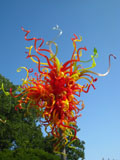 Yellow Tower |
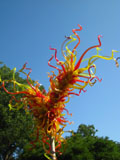 Scarlet Tower |
Going through the portal, we find ourselves at the upper fountain at the beginning of the stairstepped water feature leading downwards.
Installation Name: Neodymium Reeds
|
Chihuly made the first Reeds in Finland, and these are the same tall, thin sculptures that we would find throughout the garden, in different colors to complement their location. These long, cylindrical pieces look like spears stuck in the ground, and Chihuly is fond of using them in outdoor installations both for their durability and their dramatic effect. These reeds have another, different sculpture at their base (a piece that was unnamed). There are clickable thumbnails below for two other pictures that Fred took of this installation:
 |
Installation Name: Aqua Blue and Amber Chandelier
|
The top of this and Chihuly's other Chandeliers is incredibly intricate, and you can see a closeup view of it here.
Installation Name: Mirrored Hornets
|
For the Mirrored Hornets, molten glass is blown into a spiral mold to make the Hornet form. The glassblower must literally unscrew the hot glass to remove the form from the mold.
There are two more pictures that I'd like you to see. One of them Fred took from the eastern end of the rectangular lawn, and it looks back west and includes the Mirrored Hornets, the Neodymium Reeds, the stairstep water feature and, beyond that, the entrance to the Woman's Garden and the two asymmetrical towers. You can see that view here.
In the view I took, I was looking north, past the Mirrored Hornets to the balcony overlooking the Poetry Garden; you can see that view here.
Installation Names: Float Boat and Carnival Boat
The next two installations were both in the infinity pool at the east end of the Woman's Garden, and they were both strikingly beautiful.
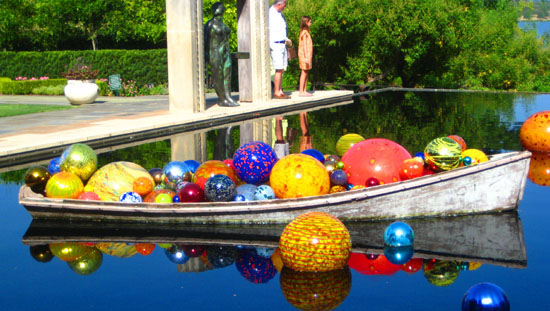 "Float Boat" |
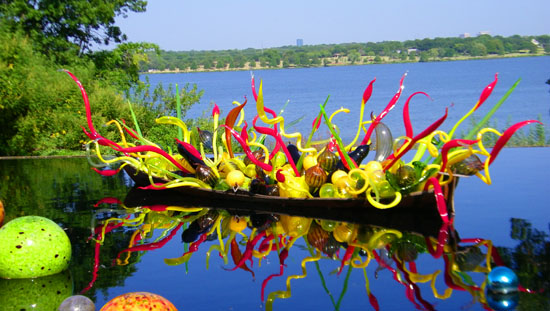 "Carnival Boat" |
Chihuly first filled boats with his glass elements in Nuutajarvi, Finland during the Chihuly Over Venice project in June 1995. After several days of glass blowing in the hotshop, the team made temporary installations along the Nuutakoki, the river nearby. For the Carnival Boat, Chihuly filled a boat with the same parts that are used in his Chandelier series. For the Float Boat, he simply filled a boat with the same sculptures that he floated in water or simply laid in gardens (like the Niijima Floats that you saw in the Jonsson Color Garden). We saw these same floats in St. Louis in the central pool of the Botanical Garden there. Chihuly made most of these parts and floats (and many other glass forms) during the Finland trip.
As I said, these installations, and the individual floats around them, were quite beautiful; the combination of the colorful sculptures and the blue water of the infinity pool plus the backdrop of White Rock Lake made for an entrancing scene. So I want to include a variety of the pictures that we took of these installations, and I have provided clickable thumbnails for them below:

|
I also made a panoramic view of the infinity pool and both installations; you can see it below:
 |
The Grotto
|
Installation Name: Persian Pond
The next installation we came to was in the pool that is part of the rock-lined water feature in The Grotto.
|
Fred took a few pictures of the watercourse here in the Grotto and, of course, the Persian Pond. I have put clickable thumbnails below that you can use to see these pictures:
 |
The Red Maple Rill
|
“The most impressive feature is a fabulous collection of over 80 varieties of 200 Japanese Maples,” commented Dave Forehand, Vice President of Gardens. “Two hundred trees are planted up and down the stream with an understory planting beneath the canopy. An especially large weeping Japanese maple nearly 100 years in age anchors the center of this new garden area.”
The Red Maple Rill increases the Dallas Arboretum’s collection of Acer species and cultivars to over 120 varieties. Not only is this garden a beautiful serene oasis along the Paseo, but is also a horticulturally important garden with an impressive collection of Maple species and cultivars.
Installation Name: Blue Polyvitro Crystals
|
Chihuly may have had th eancient stories of the old fortress in Jerusalem in mind when he developed the idea of using large crystals as a form for outdoor sculptures. The first solidly cast plastic crystals were taken from molds of cullet- broken chunks of glass retrieved from the bottom of a furnace. Polyvitro crystals were first used on the Crystal Mountain in the exhibition Chihuly in the Light of Jerusalem (1999).
The term "polyvitro" was coined by Chihuly as a name for any material used in his projects that is actually made of plastic, and created through this glass-molding process. The first crystals he made were blue, and this became their signature color. By 2005 the same large blue crystals were floated in lakes and ponds as part of Chihuly's garden exhibitions.
You can see a closeup view of two of these crystals here.
Installation Name: Sun
|
The installation sits at the edge of the Martin Rutchik Concert Lawn, just on the lawn side of the bridge that crosses the Rill. It does indeed look like a small sun that has descended to touch the earth.
Fred took two additional pictures of this installation, and there are clickable thumbnails for them below:
 |
Lay Ornamental Garden
|
Both the Lay and Trammel Crow families are major participants in Dallas philanthropy. Trammel Crow began as a small property owner and Realtor, and his companies expanded to become a leading name in office rental properties and new construction nationwide. Herman Lay, who died in 1982, began as a Pepsi-Cola bottler in Mexico, and expanded into snack foods in the 1950s. His name is currently one-half of the famous Frito-Lay snack empire which, in a not-so-odd turn, is part of PepsiCo- Herman Lay's first employer. Both men and their families have also been involved with the Morton Myerson Symphony Hall. The Trammel Crow family continues to sponsor concerts, and a branch of the Lay family donated the huge pipe organ that is the pride of the Myerson.
Installation Name: Fiori Sun
|
The installation was certainly amazing, lit as it was by the bright Dallas summer sun.
Below are clickable thumbnails for two additional pictures of Fiori Sun that Fred took:
 |
Installation Name: Blue Bulbous Reeds
|
Installation Name: Neodymium and Blue Reeds
|
Installation Name: Blue and Pink Marlins
|
Installation Name: Turquoise and Clear Eelgrass
|
Installation Name: Ferns
The additional installation below was just across the small lawn from the waterfalls:
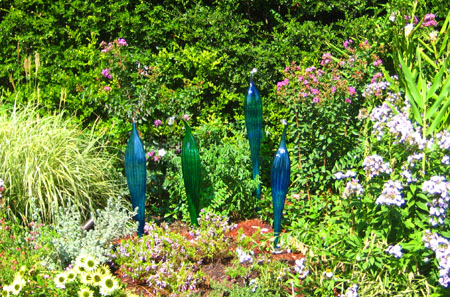 "Ferns" |
Installation Name: White Belugas
|
Below are a couple of clickable thumbnails for some additional views of the White Belugas:
 |
Paseo de Flores
|
Installation Name: Red Reeds
|
Chihuly made the first Reeds in Finland; the factory's high ceilings made the tall, thin glass sculptures possible (well, that and a mechanical life to raise the glassblower high off the floor). As Chihuly said, "In Finland we started making these long, cylindrical pieces which loojked like spears. This was an exciting new form. It was the first time we ever made anything like that. They can be taken anywhere; they can go outside. They are very strong pieces, and they are very dramatic."
That is certainly true of this installation. The view at right is probably enough, but there are clickable thumbnails below for a couple of slightly different ones:
 |
Installation Name: Ruby Fiddleheads
|
Fred got what I thought was a nice picture of me with the Fiddleheads and then we headed off the Paseo for a bit to make a stop at the test gardens, so Fred and Rudolf could see the amazing variety of new plants being tried out.
We also wanted to show Rudolf a couple of the "Artist Houses" that are currently on display south of the Paseo, so we made stops at the Pablo Picasso house and the Georges Surat house. As you can see, they are decorated in the style of the artist to whom they are dedicated. (There are two more such houses here, although we didn't go by them; they are in the styles of Van Gogh and O'Keeffe.
The test gardens are alongside an avenue of arched crape myrtle trees known as Crape Myrtle Allee. The Allee runs from the Paseo south to a large fountain known as Toad Corners. Since the test gardens put us near the south end of the Allee, and since we wanted to show Rudolf Toad Corners anyway, that's where we went next.
|
The Fountains of Toad Corners |
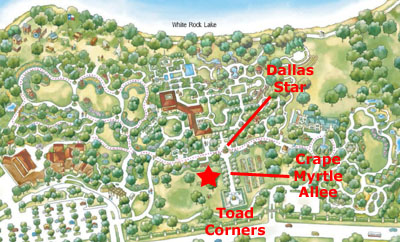
|
And while Rudolf could actually experience Toad Corners, the best way to show it to you is with a movie. You can watch that movie with the player at left.
As you can see in the movie, we walked through the Crape Myrtle Allee back up towards the Paseo de Flores and the next Chihuly installation.
Installation Name: Dallas Star
|
The Dallas Star was certainly an energetic piece, and while energy is a characteristic found in all of Chihuly's artwork, this installation exemplified it perhaps better than any other. When asked about the way he works, Chihuly answered, "Quick and immediate and spontaneous, with an element of chance." And asked about where ideas come from he said: "The only explanation I'm ever able to give about where things come from is 'energy.' That has to come out in one way or another. Sometimes it's more destructive, sometimes it's more beautiful, sometimes more creative. Energy can go in so many directions, and you have to harness it. Correction! Youy don't harness it, you use it. You put it to good use."
This was such a pretty piece that I've put clickable thumbnails below for two of Fred's pictures of it:
 |
Back on the Paseo, we headed towards the entrance and the last two Chihuly installations.
| Installation Names: | Green and White Striped Reeds Black and White Striped Reeds |
|
But then we thought that all of Chihuly's pieces were dramatic.
We continued walking down the Paseo de Flores and back to the entrance. The day had gotten very, very warm, and while the sculptures were amazing to look at, we were all ready for some shade and cool air back at home.
You can use the links below to continue to another photo album page.
 |
July 24, 2012: Rudolf and Fred at the Dallas Zoo |
 |
July 20-25, 2012: Rudolf Lowenstein Visits Dallas |
 |
Return to the Index for 2012 |